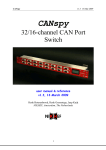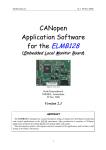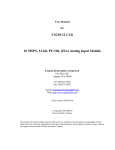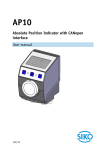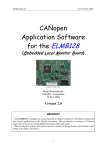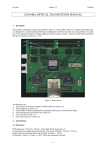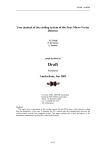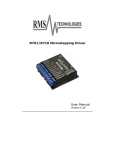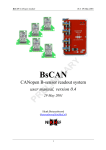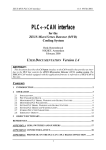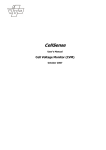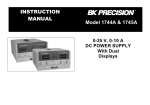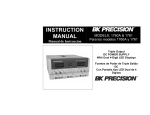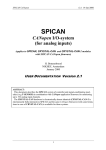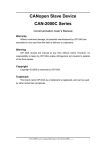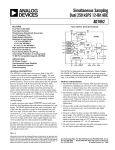Download ELMB-DAC
Transcript
DAC-module for the ELMB v1.0 3-May-2002 ELMB-DAC 16-channel 12-bit DAC-module for the ELMB user manual, version 1.0 3 May 2002 Jaap Kuijt, Paul Timmer, Björn Hallgren, Piet de Groen, Daniel Tascon Lopez, Sander Schouten, Henk Boterenbrood Amsterdam, NL Table of Contents 1 INTRODUCTION .............................................................................................................. 2 2 HARDWARE DESCRIPTION ......................................................................................... 2 3 SPEED OF OPERATION ................................................................................................. 5 4 SETTING A DAC-CHANNEL ......................................................................................... 6 5 CONNECTORS AND JUMPERS .................................................................................... 8 REFERENCES ........................................................................................................................ 10 APPENDIX A. MAX525 DAC ............................................................................................ 11 DESCRIPTION .......................................................................................................................... 11 KEY FEATURES AND SPECIFICATIONS ..................................................................................... 11 FUNCTIONAL DIAGRAM .......................................................................................................... 12 APPENDIX B. COST ESTIMATE .................................................................................... 12 APPENDIX C. SCHEMATICS .......................................................................................... 13 1 DAC-module for the ELMB v1.0 3-May-2002 1 Introduction This document describes the ELMB-DAC (Digital -to-Analog Converter) module and how to use it. The ELMB-DAC is a general-purpose DAC-module but was developed specifically to provide analog output capabilities to the ELMB module [1] plugged on its standard Motherboard. It connects directly to the 20-pin J8 connector of this motherboard. Up to four ELMB-DACs can be connected to (and powered by) one ELMB. The PCB of the ELMB-DAC can be fitted in a green box in the same way as an ELMB Motherboard does. All connectors are located at the front of the PCB. The standard CANopen ([1]) software for the ELMB+motherboard (ELMBio version 3.5, [3]) supports up to four ELMB-DACs, thus providing a total of 64 12-bit analog output cha nnels. Both current or voltage output is possible. The ELMB-DAC can be used in other systems and by other controllers (non-ELMB) as well, since it is controlled through a simple serial interface (3-wire plus a select-signal). 2 Hardware Description Summary: • 16 channels @ 12-bit using four 12-bit 4-channel MAX525 ICs ([4], and also see Appendix A. MAX525) digitally daisy-chained (Two different versions of MAX525 are available: MAX525A with 0.5 LSB 'Integral Nonlinearity', or MAX525B with 1.0 LSB 'Integral Nonlinearity'). • Controlled through a 3-wire serial interface, opto-isolated from the controller, with HCPL-0731 type optocouplers. • One-of- five module-select signal selectable by jumper, also opto-isolated. • Current output 0-20 mA, or 0-1 mA, depending on the value of one onboard resistor per channel. • Output accuracy depends on the precision of installed resistors, i.e. 1% or 0.1%. • Space for optional DIL resistor packages in case voltage output is required. • Power: o Optocouplers: powered by the +3.3V supplied on the 'digital' connector (from the ELMB, ca. 5 mA) o DAC digital circuitry: powered by the +5V supplied on the 'digital' connector (from the ELMB, ca. 5 mA) o Current-output circuitry: powered externally via a separate connection to a powersupply VE or -with restrictions- by the +5V supplied from the 'digital' connector (from the ELMB), selectable by jumpers. o Current output 0-20 mA: output circuits must be powered by the separate external powersupply VE (5 to 30V), if an ELMB is the controller of the DAC. Voltage output: ca.(VE-2.5) Volts maximum (there is also a minimum, see below). o Current output 0-1 mA: output circuit can be powered either from +5V (from the ELMB) or an external powersupply. If the ELMB is used for powering (5V), the voltage output can be ca. 2.5V maximum. 2 DAC-module for the ELMB v1.0 3-May-2002 Figure 1 below shows a blockdiagram of the ELMB-DAC. Note the jumper block used to set a module ‘address’, and the jumper selecting the power for the current output circuitry. Beware: it is always necessary to use a separate external powersupply VE for 0-20 mA current output: an ELMB is not capable to supply enough current. The external powersupply voltage VE can be in the range of +5V to +30V but some care must be taken to protect the output circuit from overdissipation. The dissipation in the output FET should be limited to ca. 200 mW (FET datasheet: 600 mW max). So for output current I=20mA, the voltage across the FET should not exceed 200mW/20mA=10V. The dissipation D in the FET is described by the following formula: D=I*(V E-2.2) Watts. This means that either VE<12.2V or that the external load has a voltage drop of at least (VE-12.2) Volts or, in other words, represent a minimum load of (VE-12.2)/20 kΩ. For example: for a 15V powersupply the output load should be at least 2.8/20 kΩ = 140 Ω. So for supply voltages of about 12V and higher a minimum load is required, if 20 mA output current is used. For 1 mA output current no minimum load is required. Table 1 summarizes the load requirements of the ELM B-DAC module. Output [mA] 0-20 mA 0-1 mA Min. Load [kΩ ] (VE-12.2)/20 0 Max. Load [kΩ ] (VE-2.2)/20 VE-2.2 Table 1. ELMB-DAC load requirements (per channel). When an ELMB powers the ELMB-DAC VE=5V (i.e. max. load at 1 mA is 2.8 kΩ ). The DOUT signal is not essential (it can only serve as a data echo) and the optocoupler for this signal could be left uninstalled. Figure 2 shows how 4 ELMB-DACs can be connected to an ELMB+Motherboard system. 3 DAC-module for the ELMB Digital In (+Po wer) +VD DIN +VA Opto coupler +VD SCLK +VA Opto coupler +VD CS0 CS1 CS2 CS3 CS4 oo oo oo DIN +VA Opto coupler v1.0 3-May-2002 output circuit power select External Po we r Analog oo +VE +VA AGND Out Vref 0-20 (0-1) mA U-to-I 0 R conversion A B SCLK MAX525 DAC C D CS DOUT +VA Vref oo address +VD DOUT DIN +VA A Opto coupler (optional) B SCLK MAX525 DAC C D CS +VA DOUT AGND +VA Vref DIN A +VD DGND Vref (+2.5V) +VA B SCLK MAX525 DAC D CS DOUT AD680 Vref C +VA Vref DIN A SCLK +VA : +5V +VD : +3.3V +VE : +5V to +30V MAX525 DAC B C D CS DOUT +VA U-to-I conversion AGND R U-to-I conversion R U-to-I conversion R U-to-I conversion R U-to-I conversion R U-to-I conversion R U-to-I conversion R U-to-I conversion R U-to-I conversion R U-to-I conversion R U-to-I conversion R U-to-I conversion R U-to-I conversion R U-to-I conversion R U-to-I conversion 0-20 (0-1) mA R AGND Figure 1. Blockdiagram of the 16-channel ELMB-DAC. In blue: digital signals, in red: power. The ‘R’s are the optional (precision) resistors for generating analog voltage outputs. Onboard connectors are shown as: 4 1 14 15 DAC-module for the ELMB v1.0 3-May-2002 CAN J8 ELMB SCLK, DIN, DOUT, 4 * CS, power Motherboard ELMB DAC ELMB DAC ELMB DAC analog out chan 0-15 analog out chan 16-31 analog out chan 32-47 ELMB DAC analog out chan 48-63 Figure 2. An ELMB + Motherboard system with 4 ELMB-DACs, providing 64 analog output channels to the ELMB application. The select-signal jumper block is shown as: (note the different setting on the individual ELMB-DACs, which is essential when ELMB-DACs are daisy-chained). 3 Speed of Operation The serial interface of the MAX525 DAC-chip can be operated at a clock rate of up to 10 MHz, but due to the (low-power/slow) optocouplers used in the board design, the speed at which the serial interface can be operated is very limited: the bit frequency cannot exceed 6 kHz or thereabouts. In practice –with four MAX525 daisy chained– it means a maximum of up to 100 DAC-channel updates per second can be achieved. Having 64 channels this means less than 2 updates per second per cha nnel. Because of this it is recommended to use the CANopen SDO message mechanism (confirmed) instead of the PDO mechanism (unconfirmed), when using the ELMB + CAN(open). See section 3 for details. A new DAC-channel setting should not be issued before the previous setting has been confirmed. This way it is guaranteed that no settings are lost. (Actually the host can run one message ahead since the ELMB can buffer one message currently…; in a next version of the ELMB software this situation will be improved). Without or with faster optocouplers the ELMB would be able to sustain a DAC-channel update rate of about 10 KHz (as compared to 100 Hz with the currently installed optocouplers). 5 DAC-module for the ELMB v1.0 3-May-2002 4 Setting a DAC-channel Users who intend to use the ELMB-DAC by a direct connection to the serial interface are referred to the MAX525 datasheet ([4]) for details on operating the serial interface. Be aware of the fact that the DAC- module has four MAX525 DACs daisy-chained ! (For example: to write something to the last DAC in the chain, write the required MAX525 command, followed by 3 socalled NOP (No Operation) commands). The ELMB software distribution contains functions for accessing the ELMB-DAC and could be used as example. Using the ELMB and the ELMBio CANopen application ([3]) as the controller of the ELMB-DACs there are 2 methods of setting DAC-channels: 1. by a socalled PDO (Process Data Object) message, which is an unconfirmed message, with no protocol overhead, or 2. by a socalled SDO (Service Data Object) message, which is a confirmed message (the user is the SDO client and the ELMB is the SDO server). Both methods are illustrated by an example. Assume the user has an ELMB-DAC with 0-1 mA output and he wants to set DAC-channel 13 to 0.5 mA (half-way the 12-bits data range, i.e. write value 0x7FF to the DAC). Using the PDO method the user wo uld send the following message to the ELMB: User → ELMBio RPDO2 COB-ID 0x300+NodeID DataByte 0 (Channel Number) 0x0D DataByte 2-3 (DAC value) 0x7FF in which RPDO stands for Receive-PDO (the CANopen application is a receiver of this PDO) and NodeId is the CAN node identifier (switch) setting on the ELMB. There is no reply to this message (a PDO is unconfirmed). It is the CANopen method of fast data transport, in which the message content has been predefined and agreed upon by sender and receiver(s). The SDO method is the CANopen way to access the ELMB's Object Dictionary –basically a table containing all parameters, settings and I/O points of the CANopen node (ELMB)– on the basis of an index and a sub-index. The one accessing the table is the client (here: the user) and the owner of the table (here: the ELMB) is the server. Using the SDO method the user would send the following SDO client message to the ELMB: 6 DAC-module for the ELMB User v1.0 3-May-2002 → ELMBio DataByte COB-ID 0 1 0x600+ 0x2B 0x11 NodeID 2 0x64 3 0x0E 4 0xFF 5 0x07 6 0x00 7 0x00 in which the following numbers can be recognized: byte 0: socalled SDO Command Specifier (here: signifying data download of 2 bytes) byte 1+2: the CANopen Object Dictionary Index (0x6411). byte 3: the CANopen Object Dictionary Sub-Index (here: channel number plus 1). byte 4+5: the DAC value (LSB first), and NodeId is the CAN node identifier (switch) setting on the ELMB. After the DAC-channel value has been written to the the ELMB-DAC the ELMB will send the following SDO server reply message, letting the SDO client (user) know that the operation succeeded: ELMBio COB-ID 0x580+ NodeID → User DataByte 0 1 0x60 0x11 2 0x64 3 0x0E 4 0x00 5 0x00 6 0x00 7 0x00 For more information about the CANopen message syntax the user is referred to the documents about the CANopen protocol ([2] and [3]). The ELMBio CANopen application supports 64 analog output (DAC) channels, where channel 0 to 15 address the ELMB-DAC with jumper CS0 installed, channel 16 to 31 the ELMB-DAC with jumper CS1 installed, channel 32 to 47 the ELMB-DAC with jumper CS2 installed and finally channel 48 to 63 the ELMB-DAC with jumper CS3 installed. See Figure 3 in the next section for the location of the jumpers. 7 DAC-module for the ELMB v1.0 3-May-2002 5 Connectors and Jumpers In Figure 3 pictures of the module's front- and backside are shown with connectors, jumpers, etc. indicated. Pin 1 -VE +VE External Power VE Connector Analog-Out Connector Digital-in Connector Socket for DIL-resistor package (channel 8-15) Pin 1 Socket for DIL-resistor package (channel 0-7) Address Selection Jumper Block, from bottom to top: CS0, CS1, CS2, CS3 and CS4 resp. Power Selection Jumper Block for output circuits, from bottom to top 2 jumpers for chan 0-3, 2 jumpers for chan 4-7, 2 jumpers for chan 8-11, 2 jumpers for chan 12-15 (shown here: all cha nnels take power from VE connector) if jumper installed: channel 0-3 powered by VE channel 0-3 powered by +5V on dig ital-in connector Figure 3. Front- and backside of the ELMB-DAC module. 8 DAC-module for the ELMB v1.0 3-May-2002 Table 2 presents the layout of the pins of the digital- in connector, and Table 3 of the analogout connector. Table 2. Table 3. not connected 20 19 not connected SCLK (from ELMB PD4) 18 17 not connected DIN (from ELMB PD5) 16 15 CS4 (from ELMB PE7) DOUT (to ELMB PD6) 14 13 CS3 (from ELMB PE6) CS2 (from ELMB PE5) 12 11 CS1 (from ELMB PE4) CS0 (from ELMB PE3) 10 9 not connected not connected 8 7 DGND in DGND in 6 5 +3.3V (+VD) in +5V (+VA) in 4 3 not used (from ELMB -5VA) AGND in 2 1 AGND in ELMB-DAC digital-in connector pin description. not connected 26 25 not connected not connected 24 23 AGND Aout 15 22 21 Aout 14 Aout 13 20 19 Aout 12 not connected 18 17 AGND Aout 11 16 15 Aout 10 Aout 9 14 13 Aout 8 not connected 12 11 AGND Aout 7 10 9 Aout 6 Aout 5 8 7 Aout 4 not connected 6 5 AGND Aout 3 4 3 Aout 2 Aout 1 2 1 Aout 0 ELMB-DAC analog-out connector pin description. 9 DAC-module for the ELMB v1.0 3-May-2002 References [1] Embedded Local Monitor Board, CERN, May 2000, (http://atlasinfo.cern.ch/ATLAS/GROUPS/DAQTRIG/DCS/ELMB/elmb.html). [2] H.Boterenbrood, CANopen, high-level protocol for CAN-bus, Version 3.0, NIKHEF, Amsterdam, 20 March 2000. (http://www.nikhef.nl/pub/departments/ct/po/doc/CANopen30.pdf). [3] H.Boterenbrood, Software for the ELMB CANopen module, Version 1.5, NIKHEF, Amsterdam, 10 January 2002. (http://www.nikhef.nl/pub/departments/ct/po/doc/ELMB15.pdf). [4] Low-Power, Quad, 12-bit Voltage Output DAC with Serial Interface, MAXIM product datasheet, 19-1098 Rev 1, Dec 1996, (http://www.maxim- ic.com/). 10 DAC-module for the ELMB v1.0 3-May-2002 Appendix A. MAX525 DAC (A brief description taken from the manufacturer's website). Description The MAX525 combines four low-power, voltage-output, 12-bit digital-to-analog converters (DACs) and four precision output amplifiers in a space-saving, 20-pin package. In addition to the four voltage outputs, each amplifier's negative input is also available to the user. This facilitates specific gain configurations, remote sensing, and high output drive capacity, making the MAX525 ideal for industrial-process-control applications. Other features include software shutdown, hardware shutdown lockout, an active- low reset which clears all registers and DACs to zero, a user-programmable logic output, and a serial-data output. Each DAC has a double-buffered input organized as an input register followed by a DAC register. A 16-bit serial word loads data into each input/DAC register. The serial interface is compatible with SPI™/QSPI™ and Microwire™. It allows the input and DAC registers to be updated independently or simultaneously with a single software command. The DAC registers can be simultaneously updated via the 3-wire serial interface. All logic inputs are TTL/CMOS-logic compatible. Key Features and Specifications Features: • Four 12-Bit DACs with Configurable Output Amplifiers • +5V Single-Supply Operation • Low Supply Current: § 0.85mA Normal Operation § 10µA Shutdown Mode • Available in 20-Pin SSOP • Power-On Reset Clears all Registers and DACs to Zero • Capable of Recalling Last State Prior to Shutdown • SPI/QSPI and Microwire Compatible • Simultaneous or Independent Control of DACs via 3-Wire Serial Interface • User-Programmable Digital Output Specifications: Data Bus Interface Resolution (Bits) Number of DACs Supply Voltage (V) Typ. Supply Current (mA) Output Type Typ. Settling Time (µs) Reference Operating Range Package Price @ 1k 3-wire Serial 12 4 +5 0.85 Voltage 12 External -40 to +85, -55 to 125, 0 to +70 20/PDIP.300, 20/SSOP $11,95 11 DAC-module for the ELMB v1.0 3-May-2002 Functional Diagram Appendix B. Cost Estimate Assuming a production series of 100 pieces, a (preliminary) price estimate of the ELMBDAC is given in Table 4. It amounts to CHF 17.50 per analog output channel. PARTS Passive components Semiconductors Connectors PCB Assembly Contingency TOTAL COST 1 154 13 (?) 20 (?) 60 30 278 Table 4. ELMB-DAC cost (prices in CHF). Prices marked with '(?)' are still uncertain. Major part of semiconductor cost determined by the four MAX525B chips. 12 DAC-module for the ELMB v1.0 3-May-2002 Appendix C. Schematics 13 DAC-module for the ELMB v1.0 3-May-2002 DAC and current output circuit for 4 channels (times 4 on the board): 14














